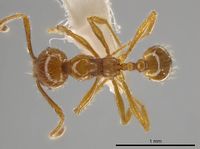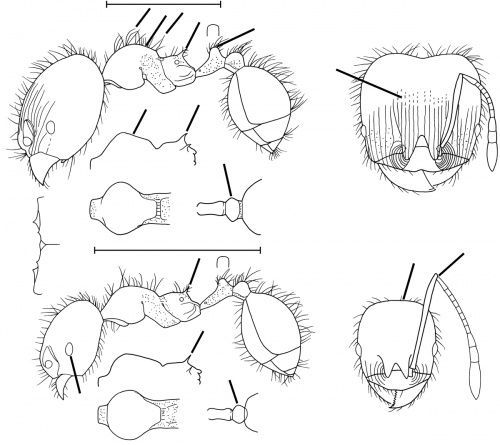Pheidole mallota
| Pheidole mallota | |
|---|---|

| |
| Scientific classification | |
| Kingdom: | Animalia |
| Phylum: | Arthropoda |
| Class: | Insecta |
| Order: | Hymenoptera |
| Family: | Formicidae |
| Subfamily: | Myrmicinae |
| Tribe: | Attini |
| Genus: | Pheidole |
| Species: | P. mallota |
| Binomial name | |
| Pheidole mallota Wilson, 2003 | |
This species is only known from type specimens. Nothing is known about its biology.
Identification
See the description in the nomenclature section.
Keys including this Species
Distribution
Only known from the type locality.
Latitudinal Distribution Pattern
Latitudinal Range: 9.4857096° to 9.4817844°.
| North Temperate |
North Subtropical |
Tropical | South Subtropical |
South Temperate |
- Source: AntMaps
Distribution based on Regional Taxon Lists
Neotropical Region: Panama (type locality).
Distribution based on AntMaps
Distribution based on AntWeb specimens
Check data from AntWeb
Countries Occupied
| Number of countries occupied by this species based on AntWiki Regional Taxon Lists. In general, fewer countries occupied indicates a narrower range, while more countries indicates a more widespread species. |

|
Estimated Abundance
| Relative abundance based on number of AntMaps records per species (this species within the purple bar). Fewer records (to the left) indicates a less abundant/encountered species while more records (to the right) indicates more abundant/encountered species. |

|
Biology
Castes
Nomenclature
The following information is derived from Barry Bolton's Online Catalogue of the Ants of the World.
- mallota. Pheidole mallota Wilson, 2003: 449, figs. (s.w.) PANAMA.
Unless otherwise noted the text for the remainder of this section is reported from the publication that includes the original description.
Description
DIAGNOSIS Similar in various traits to Pheidole amabilis, Pheidole arhuaca, Pheidole citrina, Pheidole crinita, Pheidole delicata, Pheidole hedlundorum, Pheidole laselva, Pheidole melastomae, Pheidole nitidicollis, Pheidole similigena, Pheidole terresi and Pheidole tillandsiarum, differing as follows.
Major: yellow; head as broad as long; antennal scapes long, their tips touching sides of head much more than halfway from eye to occipital corner; propodeal spines moderately long, directed backward, and curved; pilosity long, and many of the hairs curved and tangled; promesonotal profile flat; apex of petiolar node in side view broad and rounded; postpetiole from above elliptical, with angulate sides; carinulae cover only anterior half of head dorsum; most of body smooth and shiny.
Minor: eye narrow; occiput broad, convex; antennal scapes exceed occipital margins by a third their own length; propodeal spines very thin, needle-like.
MEASUREMENTS (mm) Holotype major: HW 0.90, HL 0.90, SL 0.58, EL 0.10, PW 0.42. Paratype minor: HW 0.48, HL 0.54, SL 0.60, EL 0.06, PW 0.30.
COLOR Major: concolorous medium yellow, with a dark yellow spot on vertex.
Minor: concolorous dark yellow.
Figure. FIGURE Upper: holotype, major. Lower: paratype, minor. Scale bars = 1 mm.
Type Material
PANAMA: Nusagandi, San Blas, col. Leeanne E. Tennant-Alonso. Museum of Comparative Zoology
Etymology
Gr mallota, woolly, referring to dense, curving pilosity of body.
References
- Wilson, E. O. 2003. Pheidole in the New World: A dominant, hyperdiverse ant genus. Harvard University Press, Cambridge, MA. (page 449, fig. major, minor described)
References based on Global Ant Biodiversity Informatics
- Fernández, F. and S. Sendoya. 2004. Lista de las hormigas neotropicales. Biota Colombiana Volume 5, Number 1.
- Longino J. T. L., and M. G. Branstetter. 2018. The truncated bell: an enigmatic but pervasive elevational diversity pattern in Middle American ants. Ecography 41: 1-12.
- Longino J. et al. ADMAC project. Accessed on March 24th 2017 at https://sites.google.com/site/admacsite/


